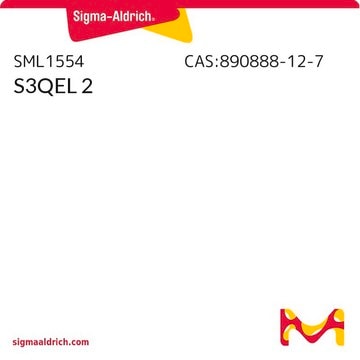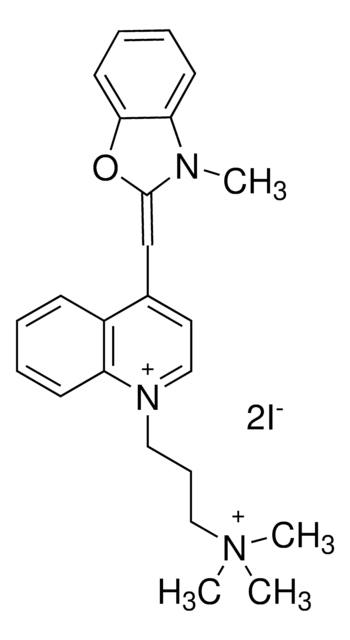SML1948
S1QEL1.1
≥98% (HPLC)
Synonym(s):
N1-(3-acetamidophenyl)-N2-(2-(4-methyl-2-(p-tolyl)thiazol-5-yl)ethyl)oxalamide, S1QEL
Sign Into View Organizational & Contract Pricing
All Photos(1)
About This Item
Empirical Formula (Hill Notation):
C23H24N4O3S
CAS Number:
Molecular Weight:
436.53
UNSPSC Code:
12352200
NACRES:
NA.77
Recommended Products
Quality Level
Assay
≥98% (HPLC)
form
powder
color
white to beige
solubility
DMSO: 2 mg/mL, clear
shipped in
wet ice
storage temp.
−20°C
SMILES string
CC1=C(CCNC(C(NC2=CC=CC(NC(C)=O)=C2)=O)=O)SC(C3=CC=C(C)C=C3)=N1
Application
S1QEL1.1 has been used as a reverse electron transport (RET)-induced mitochondrial (mito) reactive oxygen species (ROS) suppressor:
- to investigate the role of mitochondrial-derived superoxide in triggering ferroptosis
- to study the mechanism involved in the regulation of anti-fungal responses of macrophages against Aspergillus infection
- in combination with mito-antioxidant to study their influence on mitochondria-derived H2O2 in cancer cells
- to determine the effect of oxidative stress depletion on myoblast differentiation
Biochem/physiol Actions
S1QEL1.1 is a suppressor of mitochondrial respiratory complex I site IQ electron leak, suppressing superoxide and/or H2O2 production without altering oxidative phosphorylation. S1QEL1.1 had an IC50 values of 70 nM against superoxide-H2O2 production from site IQ. It decreased caspase activation in a in a cardiomyocyte cell model of ER stress and decreased ischemia-reperfusion injury in the Langendorff-perfused mouse heart model.
Suppressors of the site IQ electron leak (S1QEL)1.1 reduces cytokine secretion and fungicidal activity of macrophages infected with swollen A. fumigatus conidia by suppressing reverse electron transport (RET)-induced mitochondrial reactive oxygen species (ROS).
Storage Class Code
11 - Combustible Solids
WGK
WGK 3
Flash Point(F)
Not applicable
Flash Point(C)
Not applicable
Certificates of Analysis (COA)
Search for Certificates of Analysis (COA) by entering the products Lot/Batch Number. Lot and Batch Numbers can be found on a product’s label following the words ‘Lot’ or ‘Batch’.
Already Own This Product?
Find documentation for the products that you have recently purchased in the Document Library.
Martin D Brand et al.
Cell metabolism, 24(4), 582-592 (2016-09-27)
Using high-throughput screening we identified small molecules that suppress superoxide and/or H
Hyewon Kong et al.
Science advances, 6(45) (2020-11-06)
Mitochondria-derived reactive oxygen species (mROS) are required for the survival, proliferation, and metastasis of cancer cells. The mechanism by which mitochondrial metabolism regulates mROS levels to support cancer cells is not fully understood. To address this, we conducted a metabolism-focused
Takujiro Homma et al.
Archives of biochemistry and biophysics, 700, 108775-108775 (2021-01-26)
Ferroptosis is a type of iron-dependent, non-apoptotic cell death, which is typically induced by cysteine starvation or by the inhibition of glutathione peroxidase 4 (GPX4) activity with the accompanying elevation in lipid peroxidation product levels. Despite the central role of
Remi Hatinguais et al.
Frontiers in immunology, 12, 641495-641495 (2021-04-13)
Reactive Oxygen Species (ROS) are highly reactive molecules that can induce oxidative stress. For instance, the oxidative burst of immune cells is well known for its ability to inhibit the growth of invading pathogens. However, ROS also mediate redox signalling
Andrew G Manford et al.
Cell, 183(1), 46-61 (2020-09-18)
Metazoan organisms rely on conserved stress response pathways to alleviate adverse conditions and preserve cellular integrity. Stress responses are particularly important in stem cells that provide lifetime support for tissue formation and repair, but how these protective systems are integrated
Our team of scientists has experience in all areas of research including Life Science, Material Science, Chemical Synthesis, Chromatography, Analytical and many others.
Contact Technical Service








